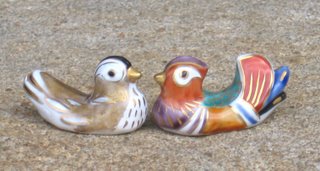:::::::::::::::::::::::::::::::::::::::::::::::::::::::::::::::::::::::::::::::::::::::::::::::::::::
Ships Flags with Daruma
tairyoobata, tairyooki 大漁旗
tairyobata
Fishing boats use to hoist a special celebration flag on the New Year and when they have made an exceptionally good catch. These are the Flags for a Bountiful Catch, tairyoobata.
Lately, some young fishermen have not seen these flags hoisted any more in the Sea of Ochotsk because the catch of fish has become much less than 30 years ago!
...........................................

CLICK for more photos !
Fresh From the Sea:
Tairyobata and the Culture of Fishing in Japan
No place in Japan is more than 70 miles from the sea. As a result, fresh fish is an important part of the Japanese diet. More importantly, it is fishing itself that has provided a reliable livelihood that is as old as human habitation in the Japanese archipelago. Through a wide variety of objects including banners, costumes, specialized equipment for various types of fishing as well as art images, this exhibition examines the culture and lore of this economic activity.
It also highlights the importance of products of the sea forming a rich visual vocabulary of symbolic images and artifacts. Principal among the objects in the show are giant, colorful flags called tairyobata ('big catch banners') flown from fishing vessels for celebratory purposes.
© Morikami Museum 2006
...........................................
Lasting Tradition
By Tatsuya Sakamoto
For centuries, the Japanese have delighted in special events associated with the seasons, such as tairyobata--fishermen's flags --kites and wind-bells, which rely on the wind to bring them to life.
But these traditional handcrafted items are on the verge of disappearing, as are the artisans who make them.
Every village or town flies its own kites as they are loved by local people. This is especially true of Tsugaru kites that can be seen in the snow country. Kites decorated with samurai images offer a colorful challenge to Old Man Winter as they soar in the sky, bringing cheer to the people below battling through a harsh winter.
Kites also are particularly popular in Shirane, Niigata Prefecture, which for 300 years has hosted a battle between giant kites. Teams line up on opposite sides of a river and try to bring their opponents' kites down by cutting the kite strings.
Many people say that the tinkling of a wind-bell in summertime makes them feel cooler. In olden days, nobles would hang wind-bells from the eaves at the four corners of their houses to ward off evil spirits. Later, craftsmen started making the wind-bells from glass, and in the late Edo period (1603-1867) they came into general use during summer.
Tairyobata were originally hoisted by returning fishing boats to indicate a bountiful haul. But now they are used mainly as decorations for such events as ship-launching ceremonies.
It is difficult to preserve and maintain these traditional manufacturing methods and events because Japan's traditions are disappearing as a result of its economic growth and the Westernization of lifestyles.
I met craftsmen who insisted on handcrafting what they produce--perserving with time-honored methods in the face of changing times and mass production.
One craftsman I met said that at one time he thought he would not continue in the family business because the family was so poor. But when his father died, he took over. Now, he said, he has to train his son to succeed him, otherwise there will be no one left capable of restoring national treasures.
Shinto rituals too are at risk. For example, Fujimori Shrine in Kyoto, has for 1,200 years held a horse-riding event, and the derring-do and horsemanship of participants was famed throughout the land. But the farm tracks on which the horse-riding event was held have now become part of a residential area. Local people say they no longer have the opportunity to ride in their daily life, and have to take part in the ritual by riding a rented horse without an opportunity to rehearse. And although spectators are thrilled by the event, the shrine has to take out accident insurance to cover the riders.
© The Yomiuri Shimbun.
...............................................................................
................... External Japanese LINK
Various Patterns used for these flags
Study Group for these flags
Store selling these flags
:::::::::::::::::::::::::::::::::::::::::::::::::::::::::::::::::::::::::::::::::::::::::::::::::::::
From Matsu Ei Maru
松栄丸
This one is about 86cm×124cm.

Detail

Photos from my friend Ishino.
:::::::::::::::::::::::::::::::::::::::::::::::::::::::::::::::::::::::::::::::::::::::::::::::::::::
Dai Go, Number Five

© PHOTO : rockfishing.naturum.ne.jp
:::::::::::::::::::::::::::::::::::::::::::::::::::::::::::::::::::::::::::::::::::::::::::::::::::
From Sumiyoshi Maru, a tile transporting ship, on display at the tile museum in Kikuma.
Kikuma Museum, Shikoku and the Daruma Kiln
:::::::::::::::::::::::::::::::::::::::::::::::::::::::::::::::::::::::::::::::::::::::::::::::::::::
Big Fish Catch ! Tairyoo 大漁
from Matsushita Denko


© PHOTOS :shuugetu.casse.jp
陰陽道において、左が陽で右が陰とされることに由来して、達磨様の左目(向かって右)から墨を入れておくほうが良いといわれてもいます。
松下電工ホームエンジニアリング㈱
東北ナショナル設備建材㈱
クボタ松下電工外装㈱
松下電工㈱
の松下グループ4社様からのご依頼で製作させて致しました!
:::::::::::::::::::::::::::::::::::::::::::::::::::::::::::::::::::::::::::::::::::::::::::::::::::::
Amulets for a big catch
. Tsuri yuki anzen 釣行安全 safety when fishing .
:::::::::::::::::::::::::::::::::::::::::::::::::::::::::::::::::::::::::::::::::::::::::::::::::::::








No comments:
Post a Comment